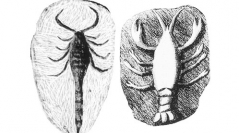

 Comptes Rendus Palevol
2 (6-7) - Pages 361-372
Comptes Rendus Palevol
2 (6-7) - Pages 361-372Gould’s observations on the falsified fossils of Morocco are completed by Cambrian and Mesozoic examples. The methods of falsification are briefly described. Gould has compared this mystification to the Beringer “Lügensteine” of the XVIIIth century. Was the Piltdown Man half human and half-ape? Was Teilhard de Chardin an accomplice in this hoax? European Paleozoic fossils were said to have been fraudulently introduced in Deprat's field localities. Accused and later rehabilitated, the question of the real origin of the fossils is still open: who is guilty? Gupta has conceived an improbable Himalayan geology, with fossils of other countries, determined with confidence by specialists. Frontals, wearing spiral horns of an unknown bovid, Pseudonovibos, were in fact falsified horns of ordinary domestic bos (Indochina). The mediatic series about Archaeoraptor, the first flying dinosaur, ended when it was recognised that the specimen is a composite, a chimera between a carnivorous dinosaur and Cretaceous bird.
Faked fossils, doubtful origin, hoax, ambition, profit